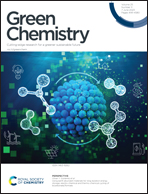Heterogeneity in enzyme/metal–organic framework composites for CO2 transformation reactions
Abstract
Enzymatic reactions represent a promising alternative to chemical catalysis, including chemical, photochemical, and electrochemical processes, for the conversion of CO2 into value-added products. However, the practical implementation of enzymes is restricted by their inherent structural fragility, inadequate stability, and limited recyclability. Recently, metal–organic frameworks (MOFs) have garnered significant interest as immobilization scaffolds to afford protection to enzymes. MOFs are a class of porous materials with immense chemical and structural tunability derived from their organic and inorganic building units. Considering that heterogeneity is a fundamental characteristic in biological systems, imparting chemical pattern, pore structure/environment, enzyme, and/or component heterogeneity in enzyme/MOF composites can significantly ameliorate the biocatalyst design. In this review, we initially discuss the existing forms of heterogeneity in enzyme/MOF systems, which are categorized as chemical pattern heterogeneity, pore heterogeneity, enzyme heterogeneity, and component heterogeneity. Subsequently, we summarize the benefits, synthetic strategies, and recent research progress for each type of heterogeneity in MOF-based biocomposites. Next, we outline the state-of-the-art enzymatic systems for the CO2 conversion reaction together with their integration in enzyme/MOF systems. Finally, we present our perspectives on the research challenges and potential future directions of biocatalytic CO2 conversion using MOF-based biocatalysts.

- This article is part of the themed collection: 2023 Green Chemistry Reviews


 Please wait while we load your content...
Please wait while we load your content...